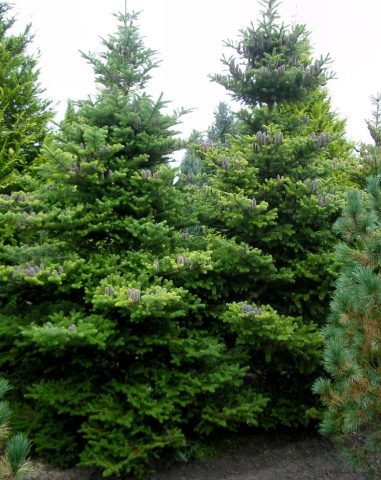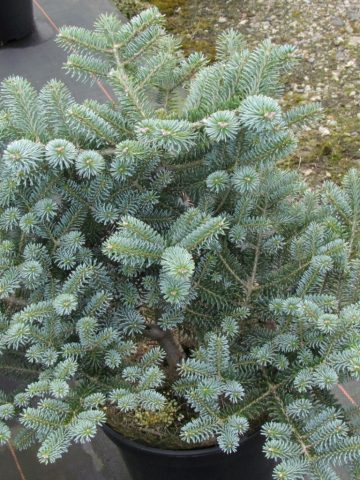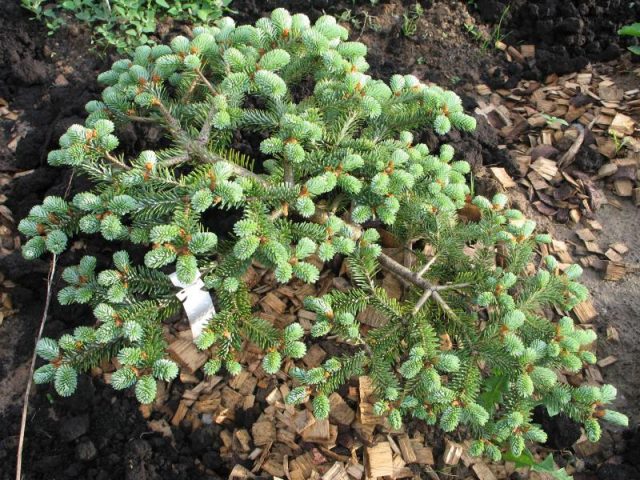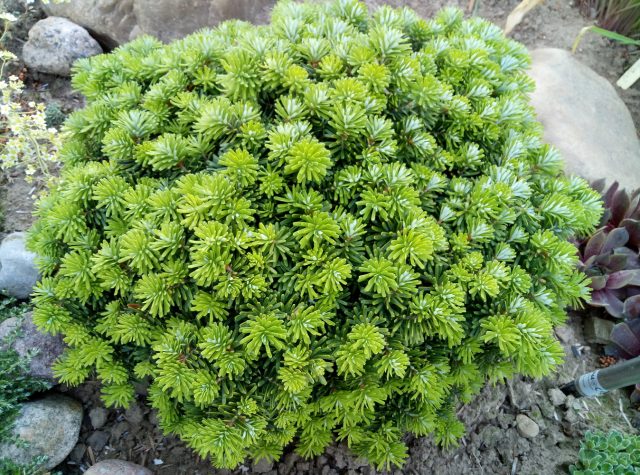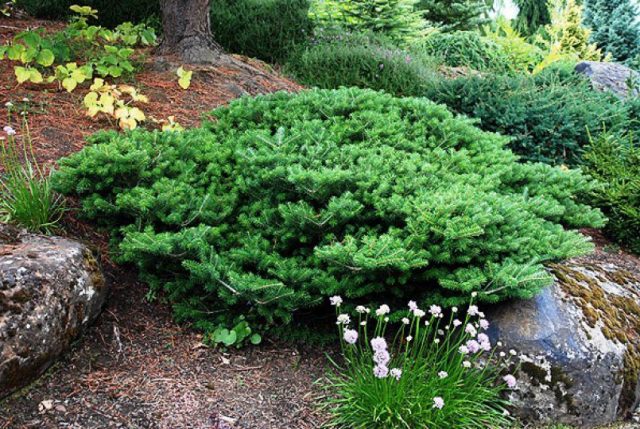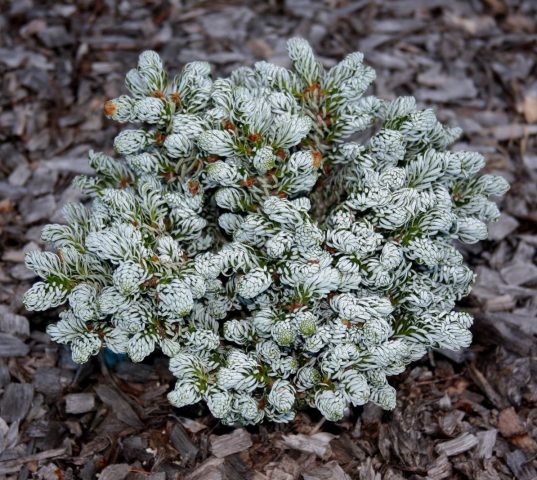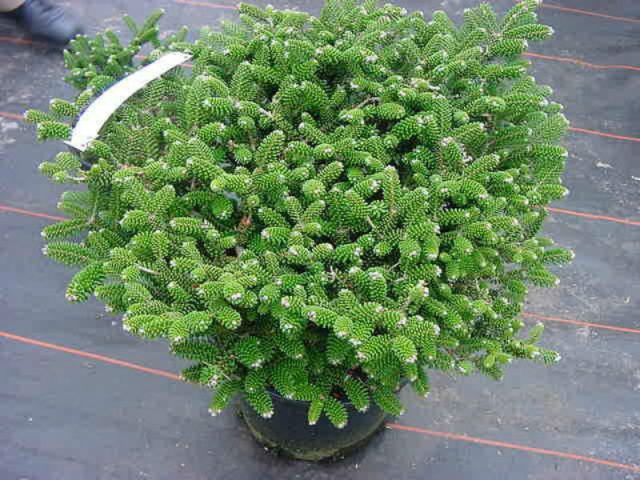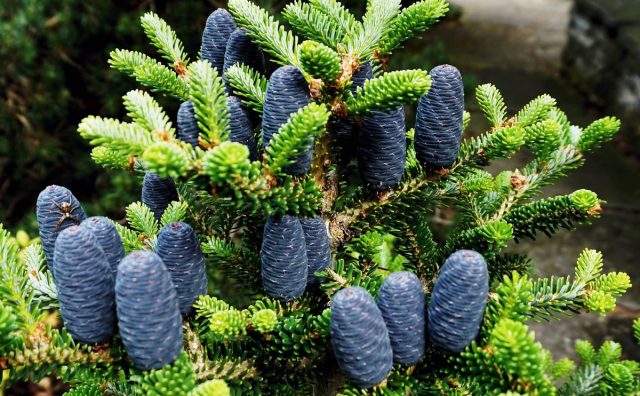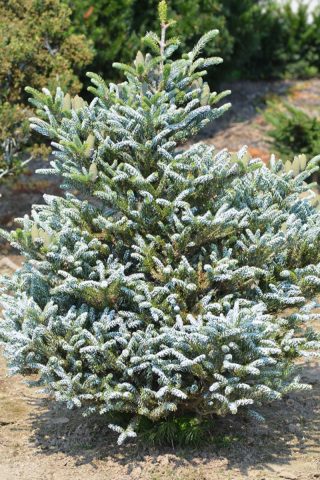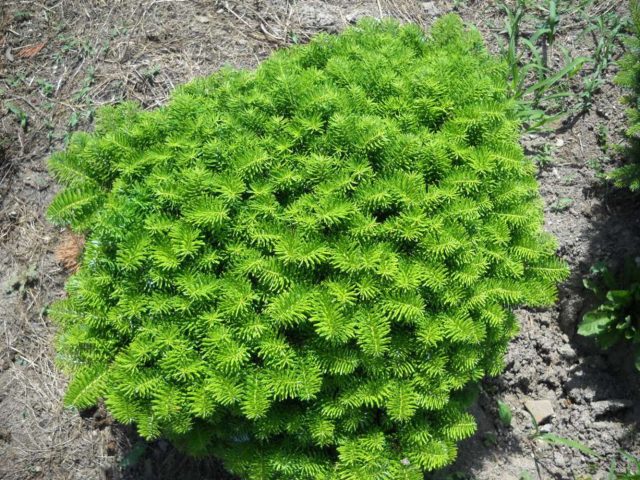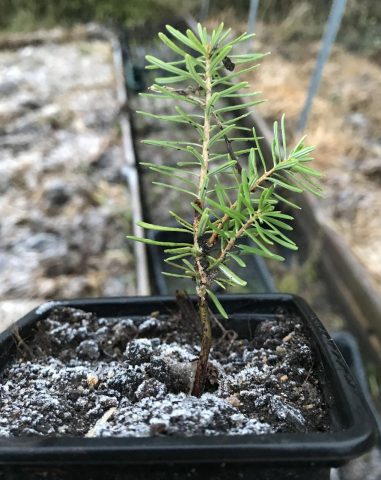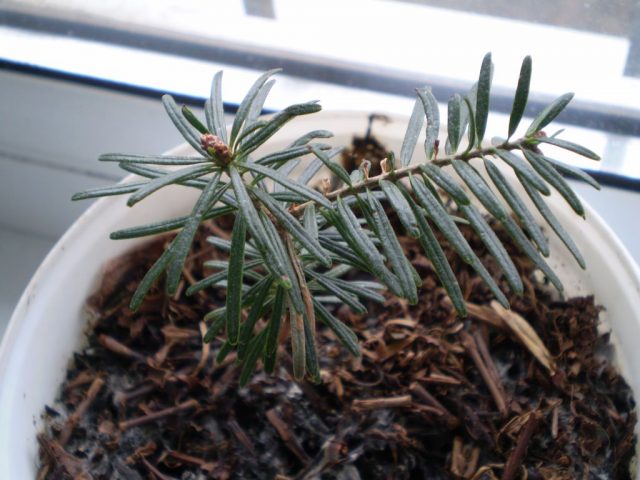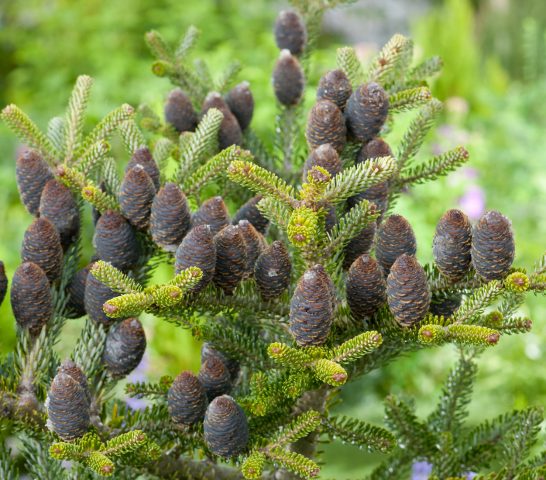Content
- 1 Description of Korean fir
- 2 Where does Korean fir grow
- 3 Korean fir in landscape design
- 4 Types and varieties of Korean fir with photo
- 5 Growing Korean fir in the Moscow region
- 6 Planting and caring for Korean fir
- 7 Features of Korean fir care at home
- 8 How to propagate Korean fir
- 9 Korean fir pests and diseases
- 10 Conclusion
- 11 Reviews of Korean fir
Korean fir is an excellent option for landscaping the territory. It is grown both in open areas and at home. The development of the tree is influenced by the planting site, the flow of moisture and nutrients.
Description of Korean fir
Korean fir is a representative of the Pine family. Its name comes from the German "fichte", which translates as "spruce". The plant is appreciated for its beautiful appearance and unpretentiousness.
The evergreen plant has a powerful root system. Young trees have smooth and thin bark, grayish shade. Over time, the surface becomes thicker, cracks appear on it. The height of the Korean fir reaches 15 m. The trunk diameter is from 0.5 to 0.8 m. The crown is wide, in the form of a cone.
Young branches are yellow, with age they acquire a purple color. The buds are resinous, spherical. The needles are dense, up to 15 mm long, hard, dark green above and silvery below. Cones are cylindrical in shape, up to 7 cm long and up to 3 cm in diameter. Pollination occurs by the wind. When the seeds ripen, the scales on the cones grind and fall off.
Where does Korean fir grow
Korean fir or Abies Koreana is found naturally on the Korean Peninsula. The tree prefers southern regions and heights from 1000 to 1900 m. The plant forms clean forests or lives in the vicinity of ayan spruce and stone birch.
Fir appeared in Europe in 1905. In the USSR, the tree has been known since 1939. Its features are being studied by the workers of the Botanical Garden BIN in St. Petersburg. In Russia, Korean species are only gaining popularity. They can be grown in warm regions, the middle lane, in Siberia, the Urals and the Far East.
Korean fir in landscape design
In landscape design, Korean fir is used for landscaping the territory. It is planted in park areas. The tree looks good in single and group plantings. It is placed next to maple, pine, spruce, larch. Low-growing varieties are located next to shrubs and ground cover flowers.
In summer cottages, the tree becomes the central part of the composition. Korean fir grows slowly. It is placed against the backdrop of a lawn, next to alpine slides, houses and gazebos. Perennial shade-loving grasses are planted under the Korean fir. It is convenient to use it to create a hedge together with other trees.
Types and varieties of Korean fir with photo
There are many varieties of Korean fir. They differ in crown shape, winter hardiness, color of needles and cones.
Korean fir Icebreaker
Korean fir Icebreaker is a unique variety bred in Germany. This is a dwarf hybrid with a spherical crown. In 10 years it grows up to 25 cm in height and up to 50 cm in width.A plant over 25 years old reaches 80 cm in height, the crown girth is no more than 120 cm.
The Icebreaker variety has many branchy short shoots. Twisted needles, silvery underside. Outwardly, the plant resembles a ball filled with shards of ice.
For a hybrid, an illuminated place is chosen. The plant fits well into rock gardens. A drained soil is prepared for it, which passes moisture well. Winter hardiness - up to -23 ° С.
Korean fir Blue Magic
Blue Magic variety - Korean fir with blue needles. At the age of 10 years, it does not exceed 1 m. An adult tree is up to 2 m in circumference and up to 2.5 m high. The needles are short, but densely arranged. When grown in a sunny place, the plant acquires a silvery hue, green tones appear in the shade.
Cones appear on a young tree. They are numerous, purple or purple in color. The crown shape is elongated or pyramidal. The Blue Magic variety is distinguished by its increased resistance to diseases. Without shelter, plantings endure winter frosts down to -23 ° C.
Korean fir Bonsai Blue
Bonsai Blue has unusual growth. For the first 8 years, the tree grows in width and takes on an asymmetrical shape. Then the apical shoot appears. At the age of 10 years, it reaches a height of 0.5 m, and in girth - 1 m. By this time, there are already numerous cones on the branches.
The needles are blue-green in color, soft and flat. The annual growth is about 5 cm. An adult plant grows up to 3 m. The Bonsai Blue variety is planted both in the sun and in partial shade. The hybrid is highly winter-hardy. Without shelter, it tolerates frosts down to -29 ° C.
Korean Fir Diamond
The Korean fir Brilliant is a valuable plant that belongs to natural dwarfs. Has a compact size. The shape is flat, spherical. The strength of growth is small. By the 10th year, the height does not exceed 0.4 m, and the width is 0.6 m.
The Brilliant variety has short, soft and aromatic needles. Above the needles are bright green, below - silver-blue. The annual growth is up to 4 cm. The plant is shaded for the winter. It is not afraid of frosts down to -29 ° С.
Korean fir Compact
Compacta is a dwarf Korean fir up to 0.8 m high. Its growth is 5 - 7 cm per year. The needles of the plant are short, soft. From above they are dark green, from below - silvery-blue. Young shoots are bright green in color. Cones up to 15 cm long appear on the tree. When ripe, they change color from green to purple and brown.
The Kompakta variety has a prostrate cushion crown. The height of the tree does not exceed 2 m. The girth of the crown is 1.5 - 3 m. The tree grows slowly, does not tolerate sunburn and moisture stagnation. Its winter hardiness is average, up to -20 ° С.
Korean Fir Kohouts Ice Breaker
A dwarf hybrid with a flat crown. Has a decorative look at any time of the year. At the age of 10, it grows 25 cm high and 50 cm wide. A plant over 25 years old reaches 80 cm in height and 120 cm in girth. The branches are numerous and short. The tree gives an annual growth of 4 cm.
The needles of the Kokhoust variety are twisted in such a way that its lower silvery side is visible. The crown of the tree is round, cushion-shaped. The Korean species Kohoust prefers sunny locations and drained soil. Korean fir in winter can withstand temperatures as low as -23 ° C without shelter.
Korean fir Molly
According to the description, the Korean fir Molly reaches a height of 4 - 7 m. At the same time, the crown girth is up to 3 m. The trees produce many blue-violet cones 5 cm long. This Korean species grows up to 7 cm per year. It has an even and straight trunk. Its shoots branch strongly, depart at an angle in different directions.
The crown of the Molly variety is wide, conical in shape. The needles are dense, flat, of medium length. The color is saturated green with a bluish undertone. No pruning is required.Young shoots are bright green. The cones of the plant are large, bluish-purple in tone.
The Molly variety prefers sunny areas, sensitive to temperature changes during the day. In the shade, the branches stretch out, the crown becomes looser. Trees are frost-resistant.
Korean fir Oberon
The Korean fir Oberon is a dwarf hybrid. It features a cone-shaped crown. The needles are bright green, short and glossy. The height at the age of 10 years is on average 0.4 m, and the width is 0.6 cm. Often the plant does not even reach 30 cm. The growth of the tree is up to 7 cm per year.
On the shoots of the plant there are soft needles with curled edges. Vertical buds grow on two-year-old branches. Their scales are dense and resinous.
The Korean variety Oberon needs fertile, moist soil. At first after planting, the plant is provided with partial shade. The frost resistance of the hybrid is up to -29 ° C.
Korean fir Silberlock
The Korean fir Silberlocke stands out with a conical crown. Sometimes the plant has several tops. At the age of 10, its height reaches from 1.2 to 1.8 m. The needles are bent, which allows you to see their lighter underside. The hybrid got its name precisely because of this property: Silberlocke is translated from English as "silver curl".
The Korean variety Silberlock develops slowly, its annual growth does not exceed 5 cm. It gives dark purple cones, up to 7 cm long. Planting in the sun or in partial shade is allowed, but it is recommended to protect the tree from sunburn.
Korean fir Silver
Silver is another representative of the Korean fir with blue cones. This is a low-growing tree no more than 6 m high. Its crown is narrow, conical, very dense. In the lower part, its diameter is no more than 1.5 m. The needles of the plant are short, no more than 2 cm in length. The needles are bluish green on one side and silvery on the other. The color of the needles is very bright compared to other varieties.
Numerous cylindrical cones up to 7 cm long grow on the shoots.Their growth begins at a young age. When ripe, the buds are green, purple and reddish in color.
Korean fir Tundra
A dwarf variety, has a symmetrical dense pillow-shaped crown. Its height is up to 40 cm, in girth - no more than 0.6 m. At the age of 10 years, the tree grows up to 30 cm, develops slowly.
Young shoots are bright green in color. The needles do not change color in winter. The plant's needles are soft, short, glossy, silver on the underside. The variety is unpretentious, tolerates shade well, but is sensitive to lack of moisture and develops worse on sandy soils. Its winter hardiness is up to -29 ° C.
Growing Korean fir in the Moscow region
Korean fir takes root well in the Moscow region. It is best to buy a seedling from your local nursery. Such plants are adapted to the conditions of the middle zone.
Most of the region belongs to the fourth climatic zone. For planting, varieties are chosen that can withstand a temperature drop down to -29 ° C. If you use less winter-hardy hybrids, then there is a great risk of freezing of their tops. Such plants definitely need shelter for the winter.
The best varieties for growing in the Moscow region:
- Bonsai Blue;
- Diamond;
- Oberon;
- Tundra.
Planting and caring for Korean fir
For cultivation, seedlings are chosen under four years old. Fir is planted in Korean spring in April. For work, it is better to wait for a cloudy day when there is no direct sunlight. A prerequisite is fertile moist soils. The tree grows well on loam. If moisture stagnates in the soil, then river sand is introduced into it or a drainage layer is made at the bottom of the pit. Broken brick or expanded clay is used as drainage.
Fir can be planted in Korean autumn. Then choose the period in late summer or early autumn. Plants take root in a new place before the onset of cold weather. The order of work does not depend on the selected period.
Fir planting instructions:
- Pits with a diameter of 50 cm are dug on the site to a depth of 60 cm.The dimensions are adjusted depending on the size of the seedling. The pit is left for 2 - 3 weeks for the soil to shrink.
- 2 buckets of water are poured into the bottom. The soil is dug up and a drainage layer 5 cm thick is poured.
- Half-fill the pit with a substrate containing compost, clay, peat and sand in a ratio of 3: 2: 1: 1. Additionally, 10 kg of sawdust and 250 g of Nitrofosk fertilizer are added to it.
- After 3 weeks, start planting. For this, fertile soil is poured into the pit to form a hill.
- A plant is placed on top, its roots are straightened. The root collar is positioned at ground level.
- The roots are covered with the remaining substrate, which is carefully compacted.
- The fir is watered abundantly.
When planting different trees, leave at least 2.5 - 3 m between them. At first, the seedling is not watered. From the hot sun, it is covered with paper caps.
Crop care includes watering and feeding. After adding moisture, the soil is loosened. A layer of peat or sawdust mulch is poured into the trunk circle. Top dressing begins from the 2nd - 3rd year. In the spring, 100 g of Kemir fertilizer are placed in the trunk circle. Any mineral complex for conifers is suitable for feeding.
For the winter, young fir is covered with agrofibre. The insulation is attached to the wooden frame. Humus or sawdust is poured into the trunk circle.
Korean fir cutting
In Korean species, the crown forms naturally. It is enough to cut dry, broken and diseased shoots. The procedure is carried out in spring or autumn, when there is no active sap flow. Dwarf hybrids do not need this treatment.
Features of Korean fir care at home
Care and cultivation of Korean fir at home have their own characteristics. For planting, dwarf hybrids are chosen that grow slowly. After buying a seedling, it is kept in cool conditions. When the tree adapts, they begin to transplant it.
To do this, be sure to purchase a container with drainage holes and a pallet. For fir, a pot with a volume of 5 - 10 liters is suitable. Every two years in the fall, the tree is transplanted into a larger container. A nutritious neutral substrate is prepared under the fir. The necessary soil is purchased in a garden store or obtained by mixing peat, sand and turf.
Caring for a tree at home includes spraying with warm water in the heat. It is also necessary to ensure that the soil does not dry out. In the spring, fertilizing with complex fertilizers will be effective.
How to propagate Korean fir
For propagation of Korean fir, one of the methods is chosen: seeds, cuttings or layering. The process is quite slow and time consuming.
How to grow Korean fir from seeds
To grow Korean fir from seeds, it is important to properly prepare the cones. The fact is that when they ripen, the seeds fly away immediately, so it is difficult to collect them. It is best to find an immature bump and keep it dry. After it dries, you can remove the seeds and place them in a cool place. Planting material should be kept in a refrigerator or basement with high humidity.
The procedure for growing Korean fir from seeds:
- For planting, a substrate is prepared, consisting of sod land and sand. Seeds are planted in containers or directly on the beds.
- In April, the seeds are buried by 2 cm. Cover the planting with a film on top. There is no need to water the soil.
- The film is periodically turned over to provide fresh air.
- After 4 weeks, the first shoots appear.
- Korean fir is watered during the season. The soil is loosened and weeded from weeds.
- For the winter, the plants are covered with spruce branches.
The next year, the seedlings are transferred to a permanent place. In the first 3 - 4 years, the plant reaches a height of 40 cm. During this period, the growth of the root system takes place. The tree then develops much faster.
Reproduction of Korean fir cuttings
Cutting is a method of fir propagation, which allows you to preserve the varietal characteristics of the plant. From the parent tree, annual shoots with an apical bud are chosen. It is recommended not to cut off the processes, but to tear them off abruptly. Then a "heel" is formed at the cutting, which can increase the chance of its rooting.
The procedure is carried out in the spring, until the sap flow has begun. To protect the cuttings from fungal diseases, they are dipped in a weak solution of potassium permanganate. The place of the cut at the mother tree is treated with garden varnish and wrapped in foil.
Rooting order of cuttings:
- The shoots are placed in a substrate consisting of fertile soil, humus and sand.
- The container is covered with a transparent jar and kept warm. Plants are ventilated daily.
- For the winter, Korean fir is removed to the basement or cellar. Cuttings are protected from dampness.
- In the spring, the containers are transferred to fresh air. In the fall, fir is planted in a permanent place.
The grafting process takes a long time. The root system of the plant is formed only after 8 - 9 months. The tree develops slowly for the first 10 years. Then the strength of growth increases and remains so until old age.
Reproduction by layering
For reproduction by layering, strong young fir shoots are chosen. In the spring, they are bent to the ground and secured with a metal bracket or wire. Furrows are pre-dug with a depth of 5 cm.
The whole season the layers are looked after: they water, weed weeds, mulch with humus. They are additionally covered for the winter. After 1 - 2 years, the plants are separated from the mother tree and transplanted to a permanent place. It is best to trim the layers in several steps.
When propagating by layering, varietal characteristics are not lost. However, this method often fails to preserve the pyramidal crown: the shape of young trees can be curved.
Korean fir pests and diseases
Korean fir is resistant to diseases and pests. The greatest danger is represented by fungal infections. The needles turn yellow on the shoots and brown spots spread. These are signs of rust carried by a harmful fungus. Sick branches are removed, garden var is applied to the sections. The crown is sprayed with Bordeaux liquid at a concentration of 2%.
Preparations containing copper are effective against fungal diseases. For prevention, plants are treated in early spring after the snow melts. The cause of the appearance of the fungus is high humidity. Thinning of the crown and rationing of watering helps to avoid diseases.
Fir often loses its decorative appearance due to Hermes, a pest of evergreen crops. This is a type of aphid that causes the shoots to turn yellow. The use of the drug Antio is recommended against it. In early spring, a solution is prepared containing 20 g of the product per 10 liters of water. Plantings are sprayed immediately after the snow melts. Such treatment is effective against other pests - leaf rollers and shoot moths.
Conclusion
Korean fir is an excellent solution for decorating a suburban area. The tree is characterized by winter hardiness and good growth in the middle zone and colder regions. During the growing season, it is important to monitor the moisture content of the soil and apply top dressing.
